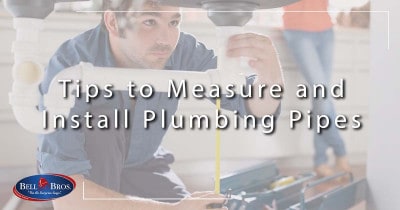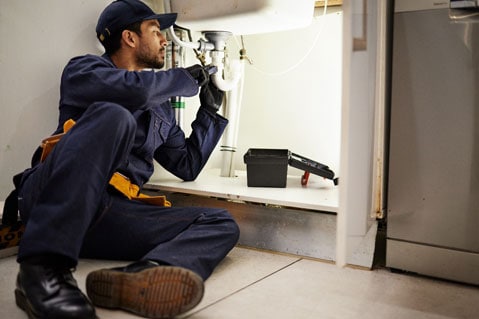
If you’re unfamiliar with the process of measuring your pipes, it may be a difficult task at first. This can make installing your plumbing pipes a headache. However, we will explain to you exactly how you can measure your pipes and provide you tips on how to install them.
Measuring Plumbing Pipes
Pipes come in various materials so measuring them can vary in process. Plumbers are normally most concerned about two measurements of pipes which are the Outside Diameter (OD) and the Nominal Pipe Size (NPS).
How To Tell What Size Pipe You Have
The size of your plumbing pipe is easily found on the pipe itself. Fittings and plumbing pipes will be labeled or printed with the NPS. For example, if you have a copper pipe the NPS will be labeled with what kind of copper the pipe is made out of. Plastic pipes will always have the wall thickness, the type of plastic it’s composed of, and the pipe size printed on the sides.
How To Measure Pipe Sizes
Below are the charts that you will need to find the NPS from your OD measurements. There are three different ways to measure pipe size and we’ll teach you how to do each method.
Copper Pipe NPS Reference Chart
| Copper Pipe Size | Outside Diameter | Pipe Circumference |
| 1/2″ | 5/8″ | 2″ |
| 3/4″ | 7/8″ | 2-5/8″ |
| 1″ | 1-1/8″ | 3-1/4″ |
| 1-1/4″ | 1-3/8″ | 4-1/8″ |
| 1-1/2″ | 1-5/8″ | 5-1/8″ |
| 2″ | 2-1/8″ | 6-5/8″ |
| 3″ | 3-1/8″ | 9-3/4″ |
| 4″ | 4-1/8″ | 13″ |
PVC, ABS, CPVC, Brass, and Steel Pipe NPS Reference Chart
| Plastic/Metal Pipe Size | Outside Diameter | Pipe Circumference |
| 1/2″ | 7/8″ | 2-5/8″ |
| 3/4″ | 1-1/8″ | 3-1/4″ |
| 1″ | 1-3/8″ | 4-1/8″ |
| 1-1/4″ | 1-5/8″ | 5-1/4″ |
| 1-1/2″ | 1-7/8″ | 6″ |
| 2″ | 2-3/8″ | 7-1/2″ |
| 3″ | 3-3/8″ | 11″ |
| 4″ | 4-3/8″ | 14-1/8″ |
Direct Diameter Measurement
If you have access to an open end of the pipe you want to measure you can use a ruler or measuring tape to measure directly across the open end of the pipe to find the direct diameter measurement. You may not be able to measure your pipe this way if it is already installed.
Outside Diameter Measurement
An easy option to measure your pipe size if you’re unable to access the open end of the pipe is to use calipers to measure the outer diameter.
Circumference Measurement
Measuring the circumference of your pipe can be a little tricky as it does involve some math. But we’ll break it down for you. Take a string or flexible tape and wrap it around the pipe. Make a mark and then measure how long the string or tape is.
Once you have the string’s length you’ll need to divide that measurement by pi (pi= 3.1415) to find the pipe’s diameter. Use the above charts to cross-reference the pipe’s OD to find the NPS.
Installation Tips
Although large and complicated projects should be left for a licensed plumber to perform, if you have a single old or broken pipe that needs to be repaired, installing your own pipes may be a good option for you. Here are some tips that can help you install your water pipes.

Start With PEX Pipes
PEX is made of a plastic material and is often less expensive than other piping materials. It can be easily attached to other pipes using simple fittings, is flexible, and cuts easily. This type of material will have a much easier installation process and is ideal if you are only replacing a small area of damage to your water pipes.
Ensure You Have The Correct Pipe Size
Now that you’ve learned how to accurately measure your plumbing pipes, you should have no problem finding out the pipe’s size. Double-check that you have the correct size before starting your project because the size of the pipe is very specific and important. Also, check all your local codes for any info on pipe size as well.

Avoid Mixing Materials
When two kinds of materials or metals are in contact with each other, they can corrode much quicker. Certain fittings can be used to prevent issues if you cannot avoid two different material pipes coming into contact. Otherwise, check to see what kind of material your old pipes are made from before starting your project to avoid this additional work.
Consider The Fittings
The part that joins two pipes together is called a fitting. They are typically placed in order to help redirect water in a different direction. Leaks can be caused when a fitting is not attached properly to both pipes. Since all pipe materials are different, they will also require different fittings which can make installing your pipes more complex.
Dry Fit The Pipes
In order to ensure that you have the correct pipe size, it’s critical to dry-fit the pipes before you complete the process of attaching them. This will make sure that your pipes will function properly once installed.
The Bell Bros. licensed professionals can help your pipe installation go smoothly and stress-free. Give us a call today to schedule your installation!

